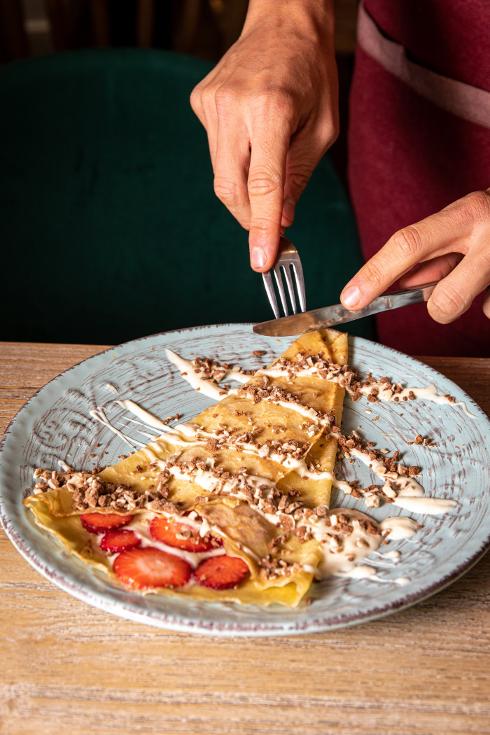

Secciones
Servicios
Destacamos

ESPERANZA PELÁEZ
Tuesday, 16 February 2021, 11:37
Today is Shrove Tuesday, Pancake Day, a day traditionally before the start of Lent, when people made basic pancakes to use up eggs and fat before starting the Lenten fast.
Although time and many generations of cooks have refined and improved the basic recipe, pancakes and crepes are derived from one of the oldest methods of making bread. To make them doesn't need a lot of skill or experience, unlike other doughs, and they are therefore perfect for introducing children to cooking as they love the soft texture and neutral flavour.
Flat breads dating back thousands of years
Thanks to archaeologist Amaia Arranz-Otaegui, there is evidence that flat breads are so ancient that their origin predates the development of agriculture and therefore the cultivation of wheat. The charred crumbs that her dig found in one of the oldest kitchens in the world in north Jordan are around 14,000 years old.
Around this fire pit were flat stones that suggest that the crumbs, whose ingredients included wild wheat (Triticum nonococcum), water and some dried, ground root vegetable, were from flat breads cooked on these stones.
After the arrival of agriculture, the selection and diversification of wheat varieties began but it took another seven to ten thousand years for bread flour to appear. In other words, humans were eating porridge and flat breads of different compositions long before 'bread' as we know it, was made.
As flat as a pancake
Ancient-style flatbreads are still found in most cultures. When the main ingredient consists of flour from cereals, beans or seeds that lack the gluten needed to keep them spongy once baked, they are sometimes used like bread, to soak up gravy and to wrap other foods.
This is the case with Mexican maíz tortillas, the huge African injeras (Ethiopia, Eritrea, Sudan), dosas from the south of India and south east Asia (made from rice and bean flour), and the Breton crepes in France, made from buckwheat flour.
Russian blinis are now made from wheat flour as well as other ingredients including yeast, but their humble original formula consisted of cooking fermented oat paste in a frying pan.
Enriched batters
In other cases, such as the French crepe or its many equivalents across Europe, wheat flour is used and the batter is enriched with various ingredients such as milk, brandy or beer, sugar and butter and in Galicia, pigs blood.
The humble, but in its own way sophisticated crepe is the result of enriching a very basic dough for special occasions.
In fact, Asturian frixuelos and Galician filloas are related to carnival festivities, just as American pancakes were originally.
French crepes are traditionally associated with the Feast of Candlemas; Chandeleur, which commemorates the Child Jesus being presented in the temple, and blinis, with Maslenitsa, which celebrates the return of the sun in spring.
Small but thick
Small pancakes or tortitas, in all their different forms, are usually made with some type of raising agent which can be obtained by using beer or water from fermented cereals, using stiffly beaten egg whites, a chemical agent or yeast. The batter is left thicker and left to rest longer.
To make crepes all that is needed is to mix water with nearly any type of flour and cook it in a greased frying pan. For best results, the mixture must be beaten well to get rid of any lumps and left to rest so that the flour can soak up some of the liquid.
If you want to enjoy more intense flavours, try grinding whole grains or seeds in a coffee grinder. This is especially worth doing for buckwheat as it is high in fat and the flour goes rancid quickly. Not only will you achieve a better taste but also the mucilage contained in the grain which binds the flour will develop better.
Traditional recipes for Breton pancakes only used flour and water but the addition of egg (unless you're vegan) creates a better batter. If you want to avoid using eggs, make smaller pancakes or tortitas as they are less likely to break up on cooking. Alternatively, add a little mashed banana to the batter or add a teaspoon of cornflour. Always use a non-stick pan or griddle, grease it well and make sure the surface of the pancake is dry before turning it over.
You can also add sugar and spices to the batter or even grated fruit. Pancakes and crepes offer the chance to be creative so get prepared to start experimenting this Tuesday.
Noticia Patrocinada
Publicidad
Sara I. Belled y Jorge Marzo
Melchor Sáiz-Pardo
Julio Arrieta, Gonzalo de las Heras (gráficos) e Isabel Toledo (gráficos)
Esta funcionalidad es exclusiva para registrados.
Reporta un error en esta noticia

Debido a un error no hemos podido dar de alta tu suscripción.
Por favor, ponte en contacto con Atención al Cliente.

¡Bienvenido a SURINENGLISH!

Tu suscripción con Google se ha realizado correctamente, pero ya tenías otra suscripción activa en SURINENGLISH.
Déjanos tus datos y nos pondremos en contacto contigo para analizar tu caso

¡Tu suscripción con Google se ha realizado correctamente!
La compra se ha asociado al siguiente email
Comentar es una ventaja exclusiva para registrados
¿Ya eres registrado?
Inicia sesiónNecesitas ser suscriptor para poder votar.